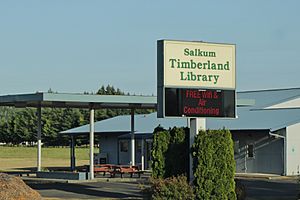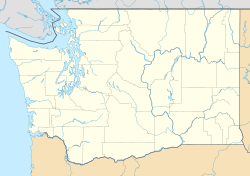Salkum, Washington facts for kids
Quick facts for kids
Salkum, Washington
|
|
|---|---|

Salkum Timberland Library in Salkum, WA
|
|
| Country | United States |
| State | Washington |
| County | Lewis |
| Elevation | 558 ft (170 m) |
| Time zone | UTC-8 (Pacific (PST)) |
| • Summer (DST) | UTC-7 (PDT) |
| zip code |
98582
|
| Area code(s) | 360 |
Salkum is a small, rural community in Lewis County, Washington. It's called an "unincorporated community" because it doesn't have its own local government like a city or town. Salkum is located along U.S. Route 12, a main road in the area. It is about 2.1 miles west of Silver Creek.
Contents
Salkum's History
Native American Roots
The land where Salkum is located was once home to the Cowlitz Indian Tribe. The name "Salkum" comes from the Cowlitz language. It means "boiling water" or "boiling up." This name refers to the waterfalls found on nearby Mill Creek.
Early Settlers and Timber
The first non-Native settlers arrived in 1881. They built a grist mill on Mill Creek. A grist mill is a place where grain is ground into flour. This mill helped start the community of Salkum.
A post office opened in Salkum in 1882. It moved in 1890, which shifted the center of the community a bit north. Salkum grew as a timber community. People worked in sawmills, cutting wood for lumber. This industry was important until the 1930s, when the sawmills closed down.
A Community Library
In 1986, Salkum opened its first library. It was part of the Timberland Regional Library system. This was a test to see if library services could work well in rural areas. The project was a success! In 1993, the community fixed up an old gas station. The library then moved into this bigger building.
Modern Infrastructure
Electric Vehicle Charging
Salkum is one of eight places getting new EV charging stations. These stations are part of a project along the White Pass Scenic Byway. This scenic road stretches from the White Pass Ski Area to Chehalis.
The project started in 2023. It is a partnership between Lewis County PUD, Twin Transit, state government groups, and local community efforts. This helps make it easier for electric cars to travel through the area.
See also
 In Spanish: Salkum (Washington) para niños
In Spanish: Salkum (Washington) para niños



